Project Management Principles: Energy Project Management in Australia
VerifiedAdded on 2021/06/17
|25
|5402
|303
Project
AI Summary
This project management assignment analyzes energy storage, solar panel manufacturing, and electric vehicles in Australia, focusing on project management principles. It examines various organizations involved in these areas, including electric car companies, residential solar panel providers, and lithium-ion battery storage firms. The report covers project overview, project management information, budget estimations, staffing plans, and risk management. It includes a detailed project task schedule using a Gantt chart and explores project constraints, stakeholder analysis, and financial models like NPV, ROI, and payback periods. The assignment aims to demonstrate an understanding of project management methodologies and their application in the context of renewable energy projects, with a focus on providing energy solutions to Australia.
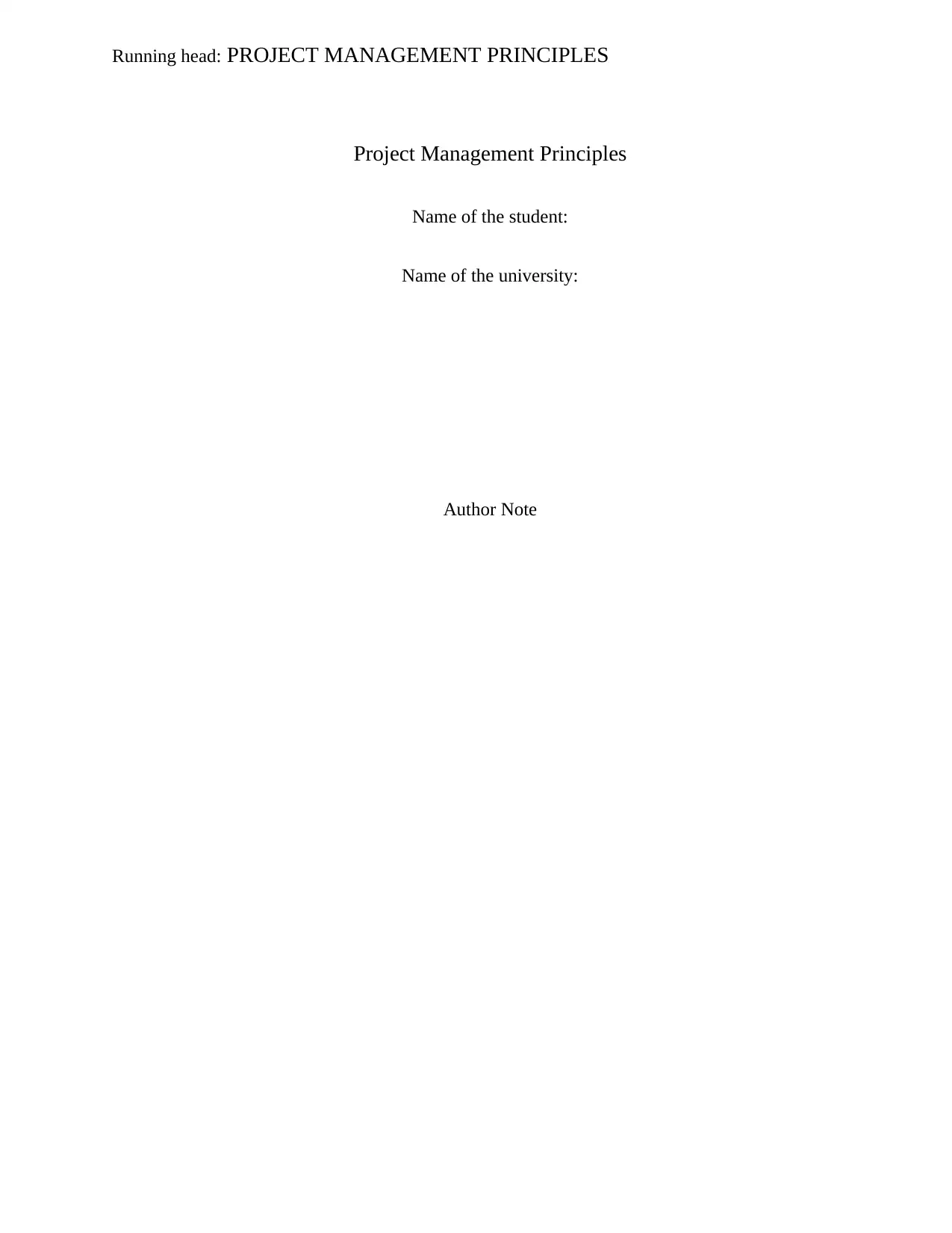
Running head: PROJECT MANAGEMENT PRINCIPLES
Project Management Principles
Name of the student:
Name of the university:
Author Note
Project Management Principles
Name of the student:
Name of the university:
Author Note
Paraphrase This Document
Need a fresh take? Get an instant paraphrase of this document with our AI Paraphraser
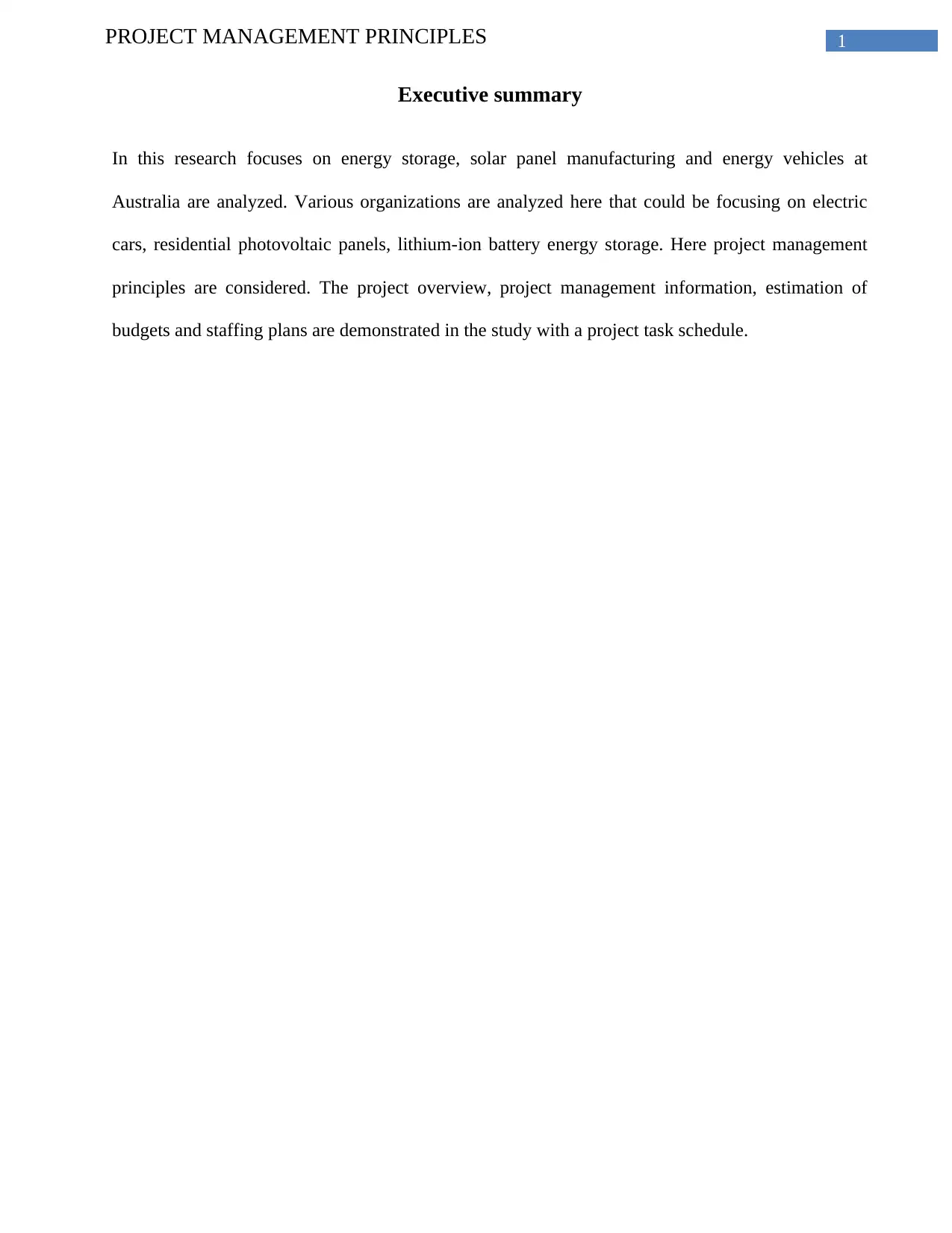
1PROJECT MANAGEMENT PRINCIPLES
Executive summary
In this research focuses on energy storage, solar panel manufacturing and energy vehicles at
Australia are analyzed. Various organizations are analyzed here that could be focusing on electric
cars, residential photovoltaic panels, lithium-ion battery energy storage. Here project management
principles are considered. The project overview, project management information, estimation of
budgets and staffing plans are demonstrated in the study with a project task schedule.
Executive summary
In this research focuses on energy storage, solar panel manufacturing and energy vehicles at
Australia are analyzed. Various organizations are analyzed here that could be focusing on electric
cars, residential photovoltaic panels, lithium-ion battery energy storage. Here project management
principles are considered. The project overview, project management information, estimation of
budgets and staffing plans are demonstrated in the study with a project task schedule.
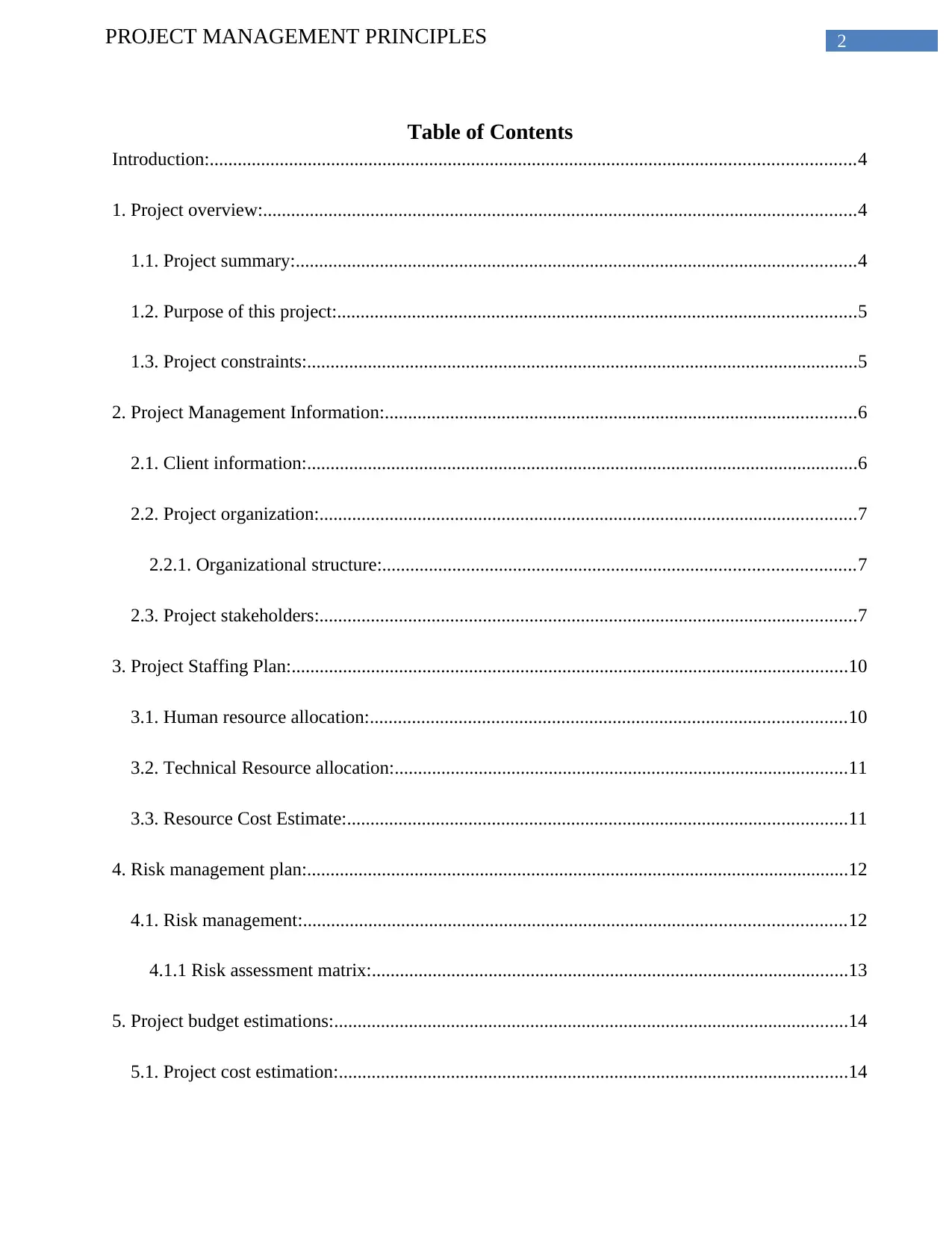
2PROJECT MANAGEMENT PRINCIPLES
Table of Contents
Introduction:..........................................................................................................................................4
1. Project overview:...............................................................................................................................4
1.1. Project summary:........................................................................................................................4
1.2. Purpose of this project:...............................................................................................................5
1.3. Project constraints:......................................................................................................................5
2. Project Management Information:.....................................................................................................6
2.1. Client information:......................................................................................................................6
2.2. Project organization:...................................................................................................................7
2.2.1. Organizational structure:.....................................................................................................7
2.3. Project stakeholders:...................................................................................................................7
3. Project Staffing Plan:.......................................................................................................................10
3.1. Human resource allocation:......................................................................................................10
3.2. Technical Resource allocation:.................................................................................................11
3.3. Resource Cost Estimate:...........................................................................................................11
4. Risk management plan:....................................................................................................................12
4.1. Risk management:....................................................................................................................12
4.1.1 Risk assessment matrix:......................................................................................................13
5. Project budget estimations:..............................................................................................................14
5.1. Project cost estimation:.............................................................................................................14
Table of Contents
Introduction:..........................................................................................................................................4
1. Project overview:...............................................................................................................................4
1.1. Project summary:........................................................................................................................4
1.2. Purpose of this project:...............................................................................................................5
1.3. Project constraints:......................................................................................................................5
2. Project Management Information:.....................................................................................................6
2.1. Client information:......................................................................................................................6
2.2. Project organization:...................................................................................................................7
2.2.1. Organizational structure:.....................................................................................................7
2.3. Project stakeholders:...................................................................................................................7
3. Project Staffing Plan:.......................................................................................................................10
3.1. Human resource allocation:......................................................................................................10
3.2. Technical Resource allocation:.................................................................................................11
3.3. Resource Cost Estimate:...........................................................................................................11
4. Risk management plan:....................................................................................................................12
4.1. Risk management:....................................................................................................................12
4.1.1 Risk assessment matrix:......................................................................................................13
5. Project budget estimations:..............................................................................................................14
5.1. Project cost estimation:.............................................................................................................14
⊘ This is a preview!⊘
Do you want full access?
Subscribe today to unlock all pages.

Trusted by 1+ million students worldwide
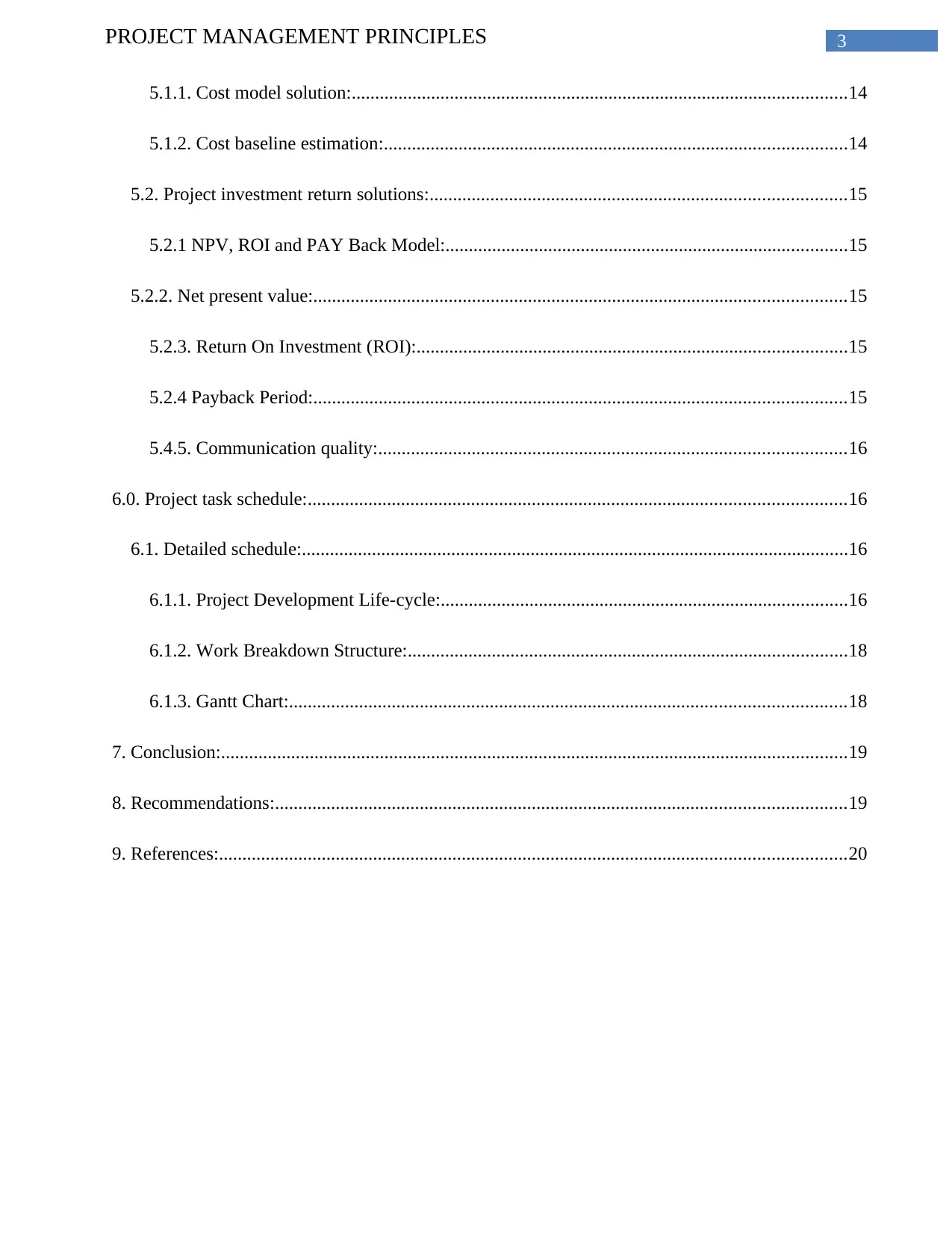
3PROJECT MANAGEMENT PRINCIPLES
5.1.1. Cost model solution:..........................................................................................................14
5.1.2. Cost baseline estimation:...................................................................................................14
5.2. Project investment return solutions:.........................................................................................15
5.2.1 NPV, ROI and PAY Back Model:......................................................................................15
5.2.2. Net present value:..................................................................................................................15
5.2.3. Return On Investment (ROI):............................................................................................15
5.2.4 Payback Period:..................................................................................................................15
5.4.5. Communication quality:....................................................................................................16
6.0. Project task schedule:...................................................................................................................16
6.1. Detailed schedule:.....................................................................................................................16
6.1.1. Project Development Life-cycle:.......................................................................................16
6.1.2. Work Breakdown Structure:..............................................................................................18
6.1.3. Gantt Chart:.......................................................................................................................18
7. Conclusion:......................................................................................................................................19
8. Recommendations:..........................................................................................................................19
9. References:......................................................................................................................................20
5.1.1. Cost model solution:..........................................................................................................14
5.1.2. Cost baseline estimation:...................................................................................................14
5.2. Project investment return solutions:.........................................................................................15
5.2.1 NPV, ROI and PAY Back Model:......................................................................................15
5.2.2. Net present value:..................................................................................................................15
5.2.3. Return On Investment (ROI):............................................................................................15
5.2.4 Payback Period:..................................................................................................................15
5.4.5. Communication quality:....................................................................................................16
6.0. Project task schedule:...................................................................................................................16
6.1. Detailed schedule:.....................................................................................................................16
6.1.1. Project Development Life-cycle:.......................................................................................16
6.1.2. Work Breakdown Structure:..............................................................................................18
6.1.3. Gantt Chart:.......................................................................................................................18
7. Conclusion:......................................................................................................................................19
8. Recommendations:..........................................................................................................................19
9. References:......................................................................................................................................20
Paraphrase This Document
Need a fresh take? Get an instant paraphrase of this document with our AI Paraphraser
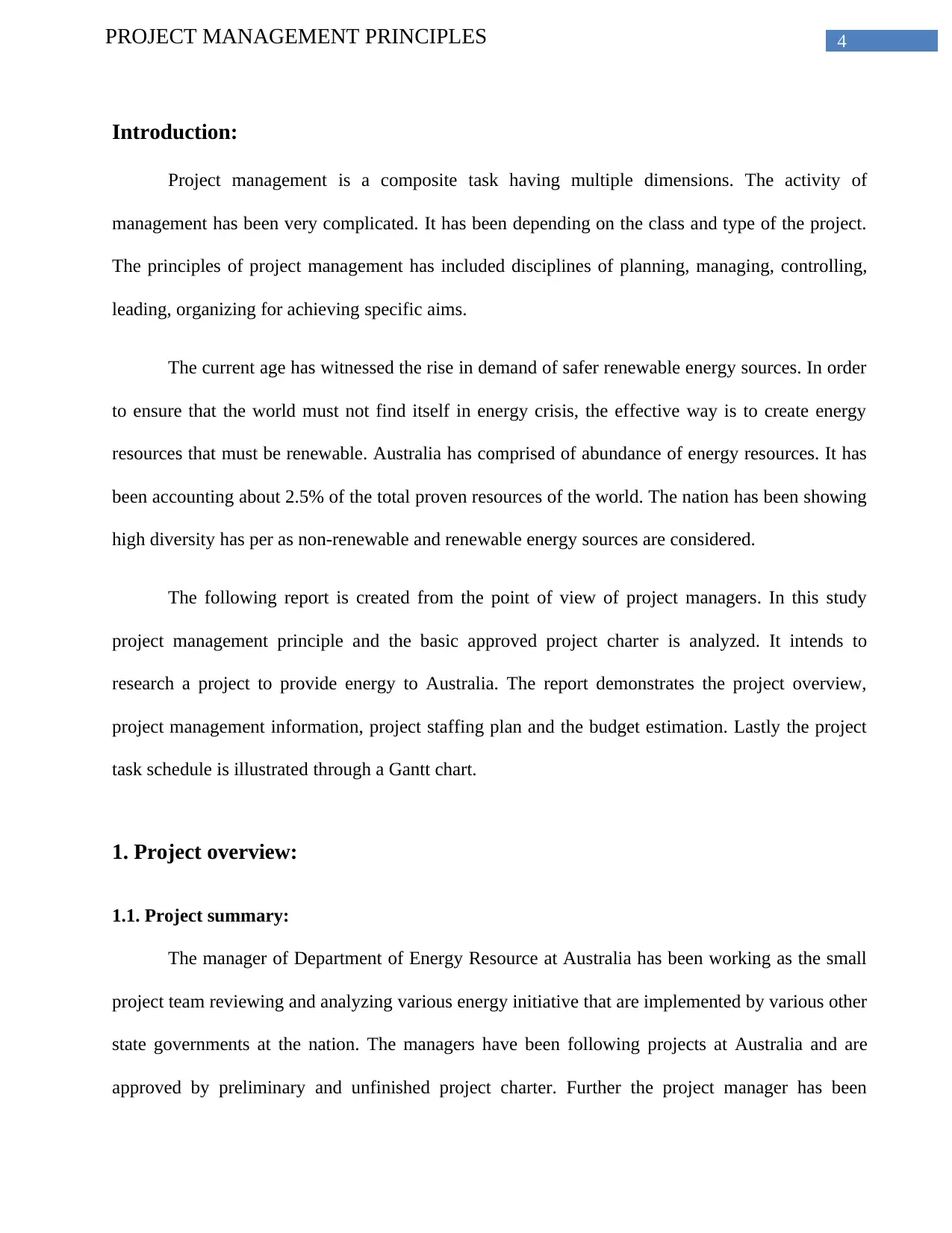
4PROJECT MANAGEMENT PRINCIPLES
Introduction:
Project management is a composite task having multiple dimensions. The activity of
management has been very complicated. It has been depending on the class and type of the project.
The principles of project management has included disciplines of planning, managing, controlling,
leading, organizing for achieving specific aims.
The current age has witnessed the rise in demand of safer renewable energy sources. In order
to ensure that the world must not find itself in energy crisis, the effective way is to create energy
resources that must be renewable. Australia has comprised of abundance of energy resources. It has
been accounting about 2.5% of the total proven resources of the world. The nation has been showing
high diversity has per as non-renewable and renewable energy sources are considered.
The following report is created from the point of view of project managers. In this study
project management principle and the basic approved project charter is analyzed. It intends to
research a project to provide energy to Australia. The report demonstrates the project overview,
project management information, project staffing plan and the budget estimation. Lastly the project
task schedule is illustrated through a Gantt chart.
1. Project overview:
1.1. Project summary:
The manager of Department of Energy Resource at Australia has been working as the small
project team reviewing and analyzing various energy initiative that are implemented by various other
state governments at the nation. The managers have been following projects at Australia and are
approved by preliminary and unfinished project charter. Further the project manager has been
Introduction:
Project management is a composite task having multiple dimensions. The activity of
management has been very complicated. It has been depending on the class and type of the project.
The principles of project management has included disciplines of planning, managing, controlling,
leading, organizing for achieving specific aims.
The current age has witnessed the rise in demand of safer renewable energy sources. In order
to ensure that the world must not find itself in energy crisis, the effective way is to create energy
resources that must be renewable. Australia has comprised of abundance of energy resources. It has
been accounting about 2.5% of the total proven resources of the world. The nation has been showing
high diversity has per as non-renewable and renewable energy sources are considered.
The following report is created from the point of view of project managers. In this study
project management principle and the basic approved project charter is analyzed. It intends to
research a project to provide energy to Australia. The report demonstrates the project overview,
project management information, project staffing plan and the budget estimation. Lastly the project
task schedule is illustrated through a Gantt chart.
1. Project overview:
1.1. Project summary:
The manager of Department of Energy Resource at Australia has been working as the small
project team reviewing and analyzing various energy initiative that are implemented by various other
state governments at the nation. The managers have been following projects at Australia and are
approved by preliminary and unfinished project charter. Further the project manager has been
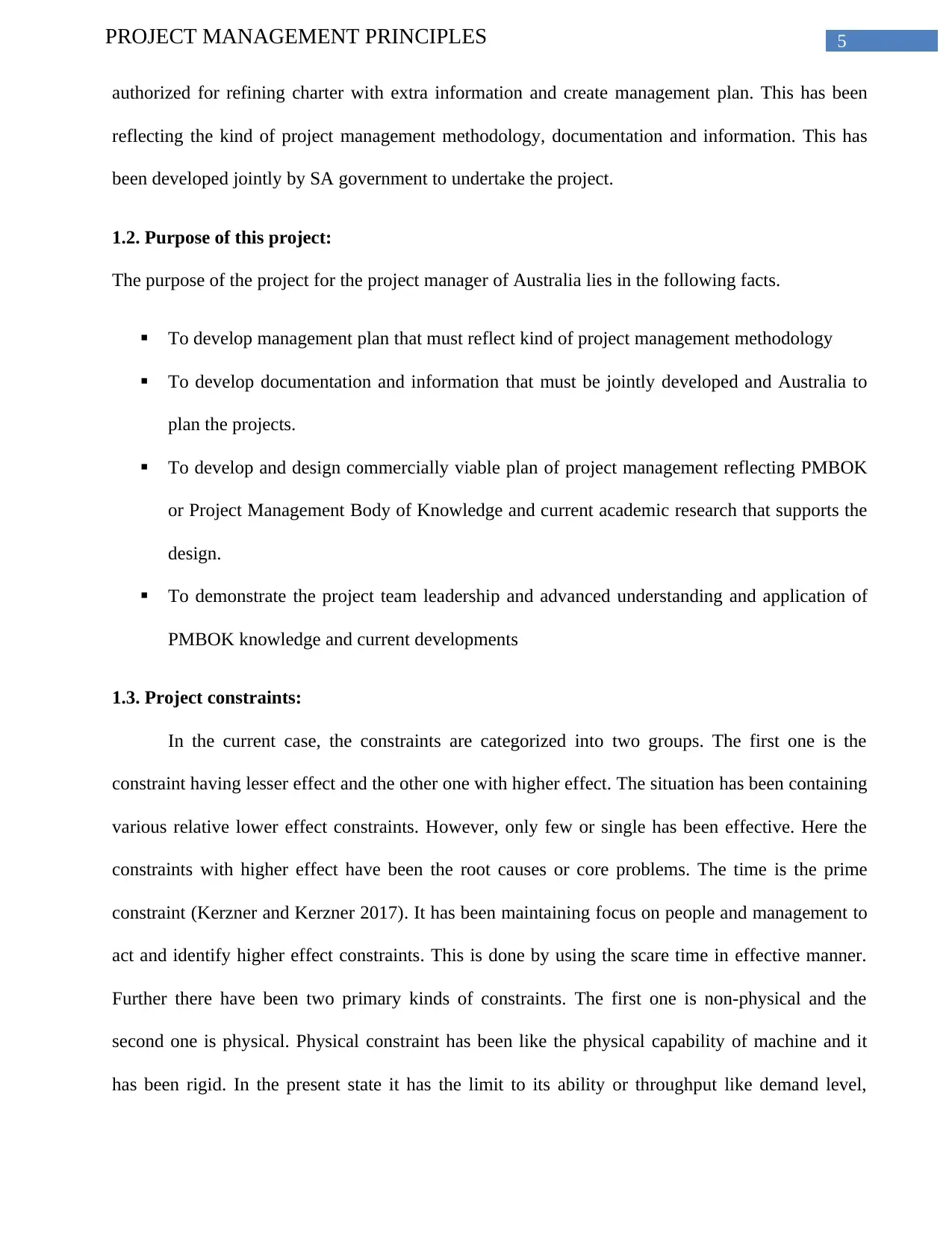
5PROJECT MANAGEMENT PRINCIPLES
authorized for refining charter with extra information and create management plan. This has been
reflecting the kind of project management methodology, documentation and information. This has
been developed jointly by SA government to undertake the project.
1.2. Purpose of this project:
The purpose of the project for the project manager of Australia lies in the following facts.
To develop management plan that must reflect kind of project management methodology
To develop documentation and information that must be jointly developed and Australia to
plan the projects.
To develop and design commercially viable plan of project management reflecting PMBOK
or Project Management Body of Knowledge and current academic research that supports the
design.
To demonstrate the project team leadership and advanced understanding and application of
PMBOK knowledge and current developments
1.3. Project constraints:
In the current case, the constraints are categorized into two groups. The first one is the
constraint having lesser effect and the other one with higher effect. The situation has been containing
various relative lower effect constraints. However, only few or single has been effective. Here the
constraints with higher effect have been the root causes or core problems. The time is the prime
constraint (Kerzner and Kerzner 2017). It has been maintaining focus on people and management to
act and identify higher effect constraints. This is done by using the scare time in effective manner.
Further there have been two primary kinds of constraints. The first one is non-physical and the
second one is physical. Physical constraint has been like the physical capability of machine and it
has been rigid. In the present state it has the limit to its ability or throughput like demand level,
authorized for refining charter with extra information and create management plan. This has been
reflecting the kind of project management methodology, documentation and information. This has
been developed jointly by SA government to undertake the project.
1.2. Purpose of this project:
The purpose of the project for the project manager of Australia lies in the following facts.
To develop management plan that must reflect kind of project management methodology
To develop documentation and information that must be jointly developed and Australia to
plan the projects.
To develop and design commercially viable plan of project management reflecting PMBOK
or Project Management Body of Knowledge and current academic research that supports the
design.
To demonstrate the project team leadership and advanced understanding and application of
PMBOK knowledge and current developments
1.3. Project constraints:
In the current case, the constraints are categorized into two groups. The first one is the
constraint having lesser effect and the other one with higher effect. The situation has been containing
various relative lower effect constraints. However, only few or single has been effective. Here the
constraints with higher effect have been the root causes or core problems. The time is the prime
constraint (Kerzner and Kerzner 2017). It has been maintaining focus on people and management to
act and identify higher effect constraints. This is done by using the scare time in effective manner.
Further there have been two primary kinds of constraints. The first one is non-physical and the
second one is physical. Physical constraint has been like the physical capability of machine and it
has been rigid. In the present state it has the limit to its ability or throughput like demand level,
⊘ This is a preview!⊘
Do you want full access?
Subscribe today to unlock all pages.

Trusted by 1+ million students worldwide
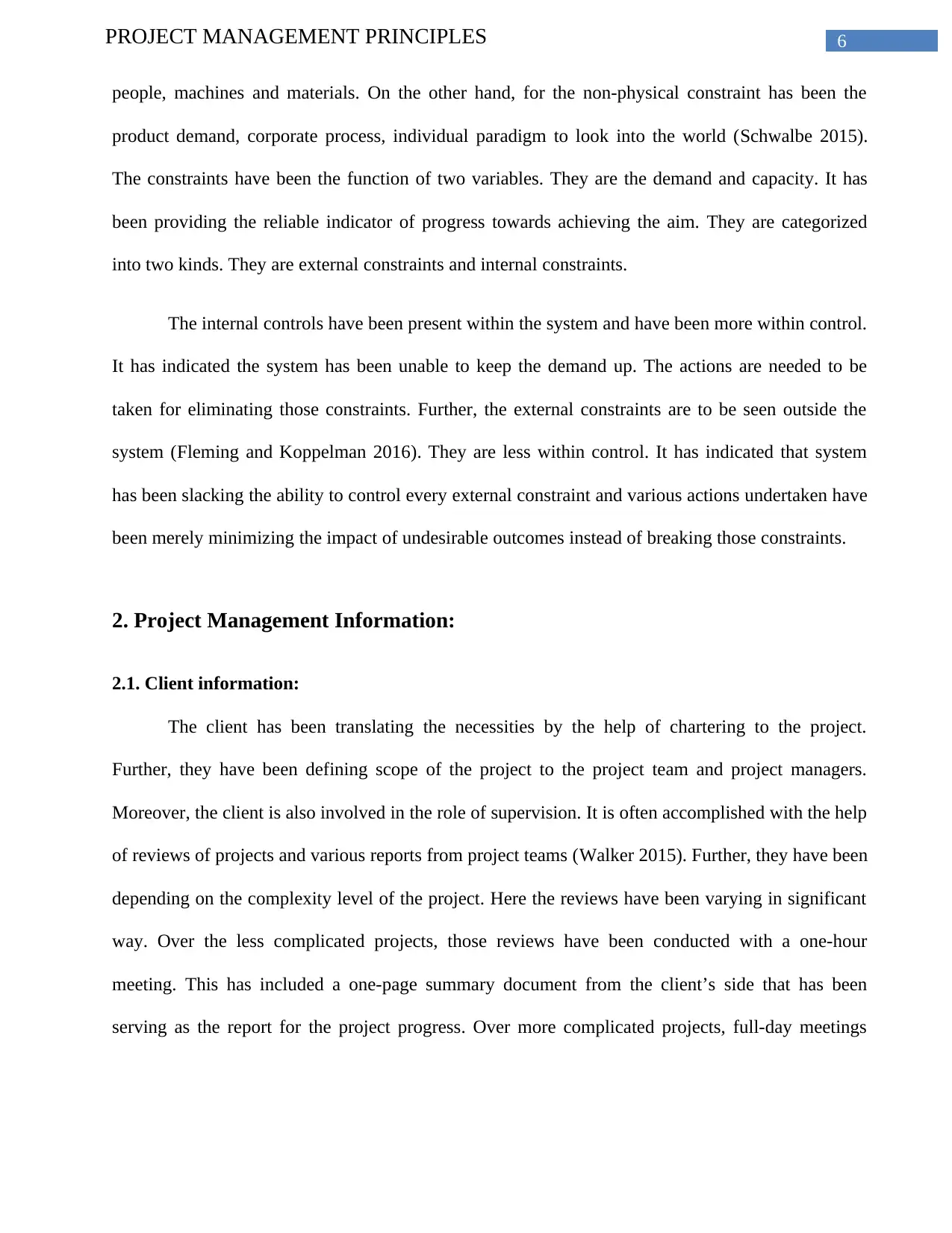
6PROJECT MANAGEMENT PRINCIPLES
people, machines and materials. On the other hand, for the non-physical constraint has been the
product demand, corporate process, individual paradigm to look into the world (Schwalbe 2015).
The constraints have been the function of two variables. They are the demand and capacity. It has
been providing the reliable indicator of progress towards achieving the aim. They are categorized
into two kinds. They are external constraints and internal constraints.
The internal controls have been present within the system and have been more within control.
It has indicated the system has been unable to keep the demand up. The actions are needed to be
taken for eliminating those constraints. Further, the external constraints are to be seen outside the
system (Fleming and Koppelman 2016). They are less within control. It has indicated that system
has been slacking the ability to control every external constraint and various actions undertaken have
been merely minimizing the impact of undesirable outcomes instead of breaking those constraints.
2. Project Management Information:
2.1. Client information:
The client has been translating the necessities by the help of chartering to the project.
Further, they have been defining scope of the project to the project team and project managers.
Moreover, the client is also involved in the role of supervision. It is often accomplished with the help
of reviews of projects and various reports from project teams (Walker 2015). Further, they have been
depending on the complexity level of the project. Here the reviews have been varying in significant
way. Over the less complicated projects, those reviews have been conducted with a one-hour
meeting. This has included a one-page summary document from the client’s side that has been
serving as the report for the project progress. Over more complicated projects, full-day meetings
people, machines and materials. On the other hand, for the non-physical constraint has been the
product demand, corporate process, individual paradigm to look into the world (Schwalbe 2015).
The constraints have been the function of two variables. They are the demand and capacity. It has
been providing the reliable indicator of progress towards achieving the aim. They are categorized
into two kinds. They are external constraints and internal constraints.
The internal controls have been present within the system and have been more within control.
It has indicated the system has been unable to keep the demand up. The actions are needed to be
taken for eliminating those constraints. Further, the external constraints are to be seen outside the
system (Fleming and Koppelman 2016). They are less within control. It has indicated that system
has been slacking the ability to control every external constraint and various actions undertaken have
been merely minimizing the impact of undesirable outcomes instead of breaking those constraints.
2. Project Management Information:
2.1. Client information:
The client has been translating the necessities by the help of chartering to the project.
Further, they have been defining scope of the project to the project team and project managers.
Moreover, the client is also involved in the role of supervision. It is often accomplished with the help
of reviews of projects and various reports from project teams (Walker 2015). Further, they have been
depending on the complexity level of the project. Here the reviews have been varying in significant
way. Over the less complicated projects, those reviews have been conducted with a one-hour
meeting. This has included a one-page summary document from the client’s side that has been
serving as the report for the project progress. Over more complicated projects, full-day meetings
Paraphrase This Document
Need a fresh take? Get an instant paraphrase of this document with our AI Paraphraser
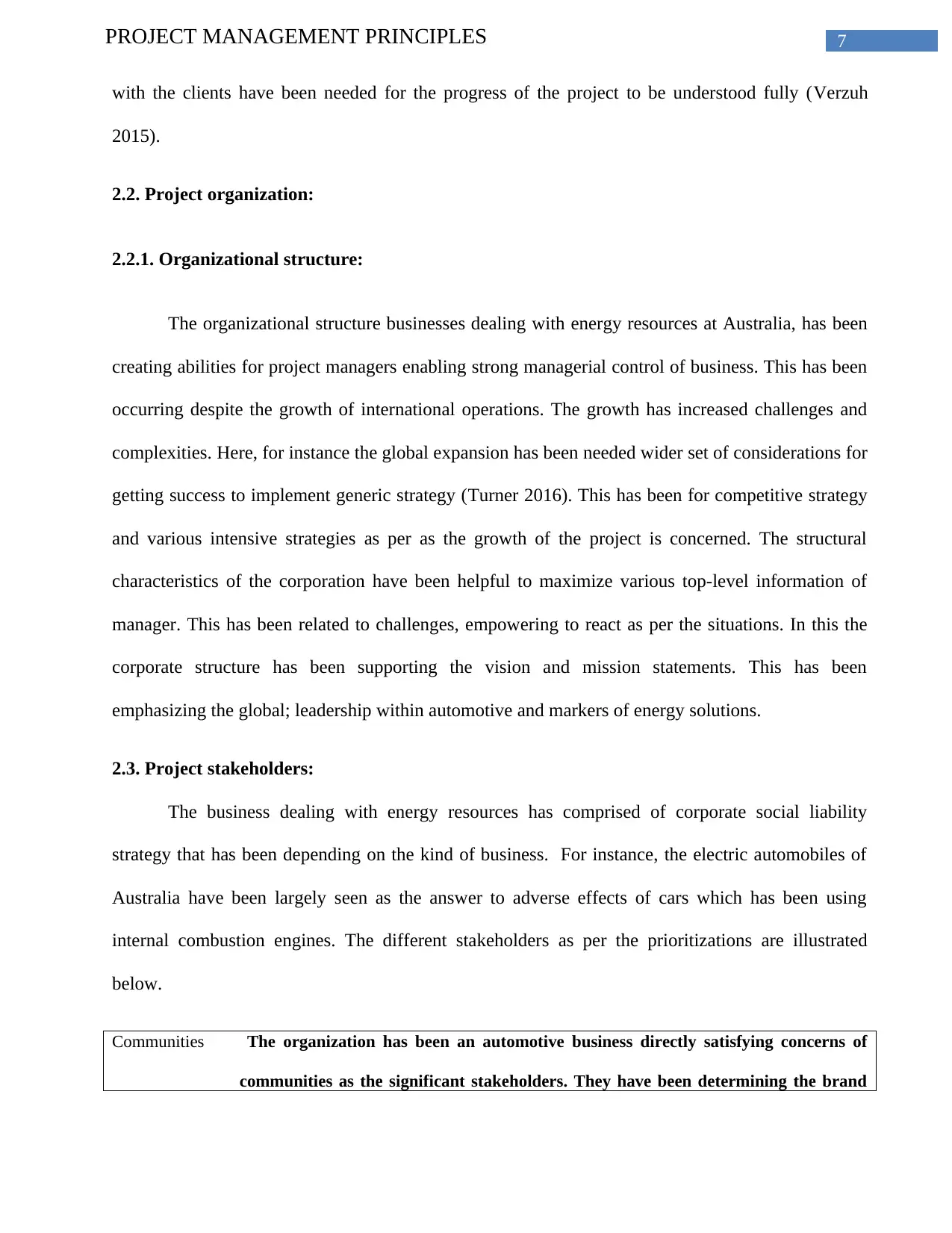
7PROJECT MANAGEMENT PRINCIPLES
with the clients have been needed for the progress of the project to be understood fully (Verzuh
2015).
2.2. Project organization:
2.2.1. Organizational structure:
The organizational structure businesses dealing with energy resources at Australia, has been
creating abilities for project managers enabling strong managerial control of business. This has been
occurring despite the growth of international operations. The growth has increased challenges and
complexities. Here, for instance the global expansion has been needed wider set of considerations for
getting success to implement generic strategy (Turner 2016). This has been for competitive strategy
and various intensive strategies as per as the growth of the project is concerned. The structural
characteristics of the corporation have been helpful to maximize various top-level information of
manager. This has been related to challenges, empowering to react as per the situations. In this the
corporate structure has been supporting the vision and mission statements. This has been
emphasizing the global; leadership within automotive and markers of energy solutions.
2.3. Project stakeholders:
The business dealing with energy resources has comprised of corporate social liability
strategy that has been depending on the kind of business. For instance, the electric automobiles of
Australia have been largely seen as the answer to adverse effects of cars which has been using
internal combustion engines. The different stakeholders as per the prioritizations are illustrated
below.
Communities The organization has been an automotive business directly satisfying concerns of
communities as the significant stakeholders. They have been determining the brand
with the clients have been needed for the progress of the project to be understood fully (Verzuh
2015).
2.2. Project organization:
2.2.1. Organizational structure:
The organizational structure businesses dealing with energy resources at Australia, has been
creating abilities for project managers enabling strong managerial control of business. This has been
occurring despite the growth of international operations. The growth has increased challenges and
complexities. Here, for instance the global expansion has been needed wider set of considerations for
getting success to implement generic strategy (Turner 2016). This has been for competitive strategy
and various intensive strategies as per as the growth of the project is concerned. The structural
characteristics of the corporation have been helpful to maximize various top-level information of
manager. This has been related to challenges, empowering to react as per the situations. In this the
corporate structure has been supporting the vision and mission statements. This has been
emphasizing the global; leadership within automotive and markers of energy solutions.
2.3. Project stakeholders:
The business dealing with energy resources has comprised of corporate social liability
strategy that has been depending on the kind of business. For instance, the electric automobiles of
Australia have been largely seen as the answer to adverse effects of cars which has been using
internal combustion engines. The different stakeholders as per the prioritizations are illustrated
below.
Communities The organization has been an automotive business directly satisfying concerns of
communities as the significant stakeholders. They have been determining the brand
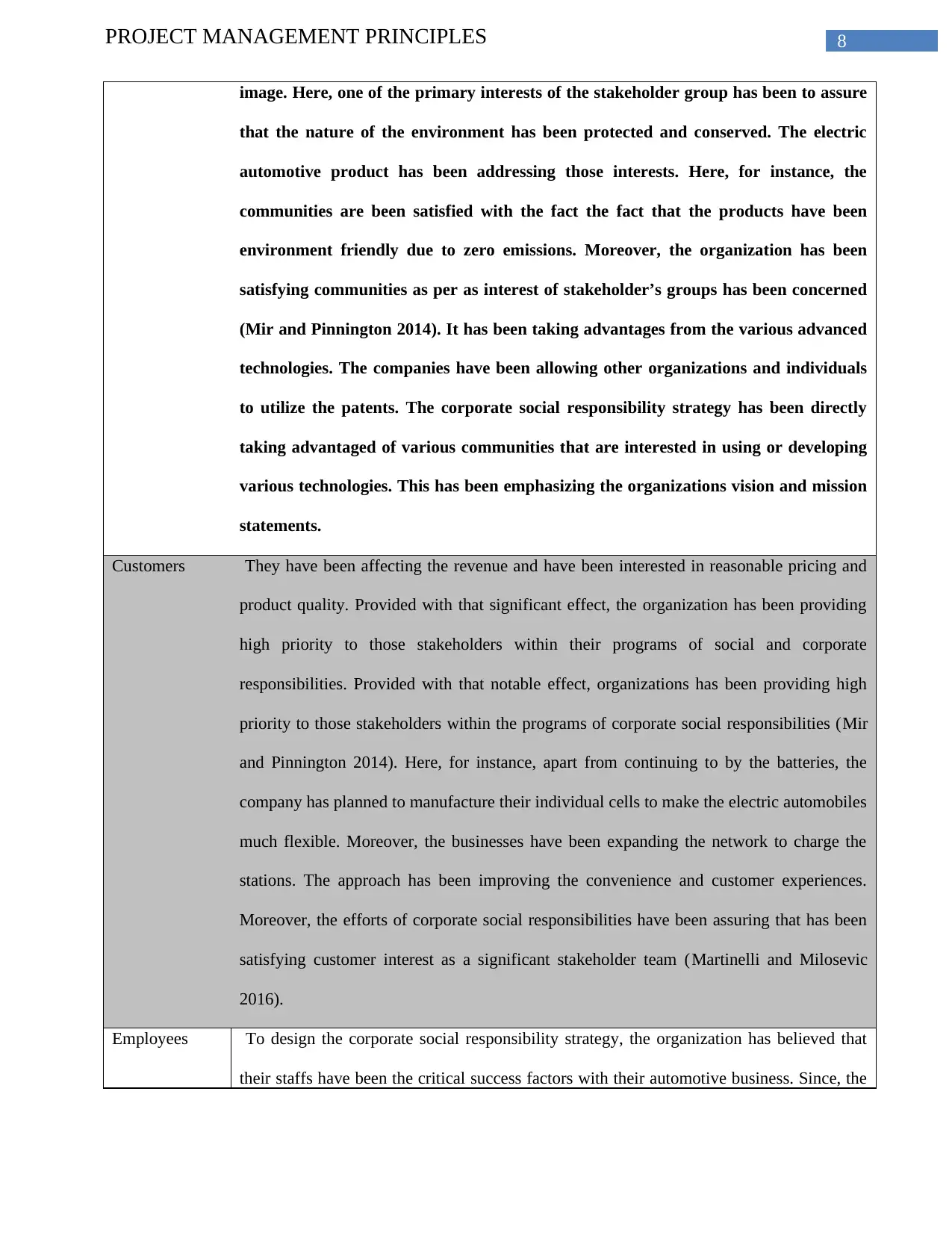
8PROJECT MANAGEMENT PRINCIPLES
image. Here, one of the primary interests of the stakeholder group has been to assure
that the nature of the environment has been protected and conserved. The electric
automotive product has been addressing those interests. Here, for instance, the
communities are been satisfied with the fact the fact that the products have been
environment friendly due to zero emissions. Moreover, the organization has been
satisfying communities as per as interest of stakeholder’s groups has been concerned
(Mir and Pinnington 2014). It has been taking advantages from the various advanced
technologies. The companies have been allowing other organizations and individuals
to utilize the patents. The corporate social responsibility strategy has been directly
taking advantaged of various communities that are interested in using or developing
various technologies. This has been emphasizing the organizations vision and mission
statements.
Customers They have been affecting the revenue and have been interested in reasonable pricing and
product quality. Provided with that significant effect, the organization has been providing
high priority to those stakeholders within their programs of social and corporate
responsibilities. Provided with that notable effect, organizations has been providing high
priority to those stakeholders within the programs of corporate social responsibilities (Mir
and Pinnington 2014). Here, for instance, apart from continuing to by the batteries, the
company has planned to manufacture their individual cells to make the electric automobiles
much flexible. Moreover, the businesses have been expanding the network to charge the
stations. The approach has been improving the convenience and customer experiences.
Moreover, the efforts of corporate social responsibilities have been assuring that has been
satisfying customer interest as a significant stakeholder team (Martinelli and Milosevic
2016).
Employees To design the corporate social responsibility strategy, the organization has believed that
their staffs have been the critical success factors with their automotive business. Since, the
image. Here, one of the primary interests of the stakeholder group has been to assure
that the nature of the environment has been protected and conserved. The electric
automotive product has been addressing those interests. Here, for instance, the
communities are been satisfied with the fact the fact that the products have been
environment friendly due to zero emissions. Moreover, the organization has been
satisfying communities as per as interest of stakeholder’s groups has been concerned
(Mir and Pinnington 2014). It has been taking advantages from the various advanced
technologies. The companies have been allowing other organizations and individuals
to utilize the patents. The corporate social responsibility strategy has been directly
taking advantaged of various communities that are interested in using or developing
various technologies. This has been emphasizing the organizations vision and mission
statements.
Customers They have been affecting the revenue and have been interested in reasonable pricing and
product quality. Provided with that significant effect, the organization has been providing
high priority to those stakeholders within their programs of social and corporate
responsibilities. Provided with that notable effect, organizations has been providing high
priority to those stakeholders within the programs of corporate social responsibilities (Mir
and Pinnington 2014). Here, for instance, apart from continuing to by the batteries, the
company has planned to manufacture their individual cells to make the electric automobiles
much flexible. Moreover, the businesses have been expanding the network to charge the
stations. The approach has been improving the convenience and customer experiences.
Moreover, the efforts of corporate social responsibilities have been assuring that has been
satisfying customer interest as a significant stakeholder team (Martinelli and Milosevic
2016).
Employees To design the corporate social responsibility strategy, the organization has believed that
their staffs have been the critical success factors with their automotive business. Since, the
⊘ This is a preview!⊘
Do you want full access?
Subscribe today to unlock all pages.

Trusted by 1+ million students worldwide
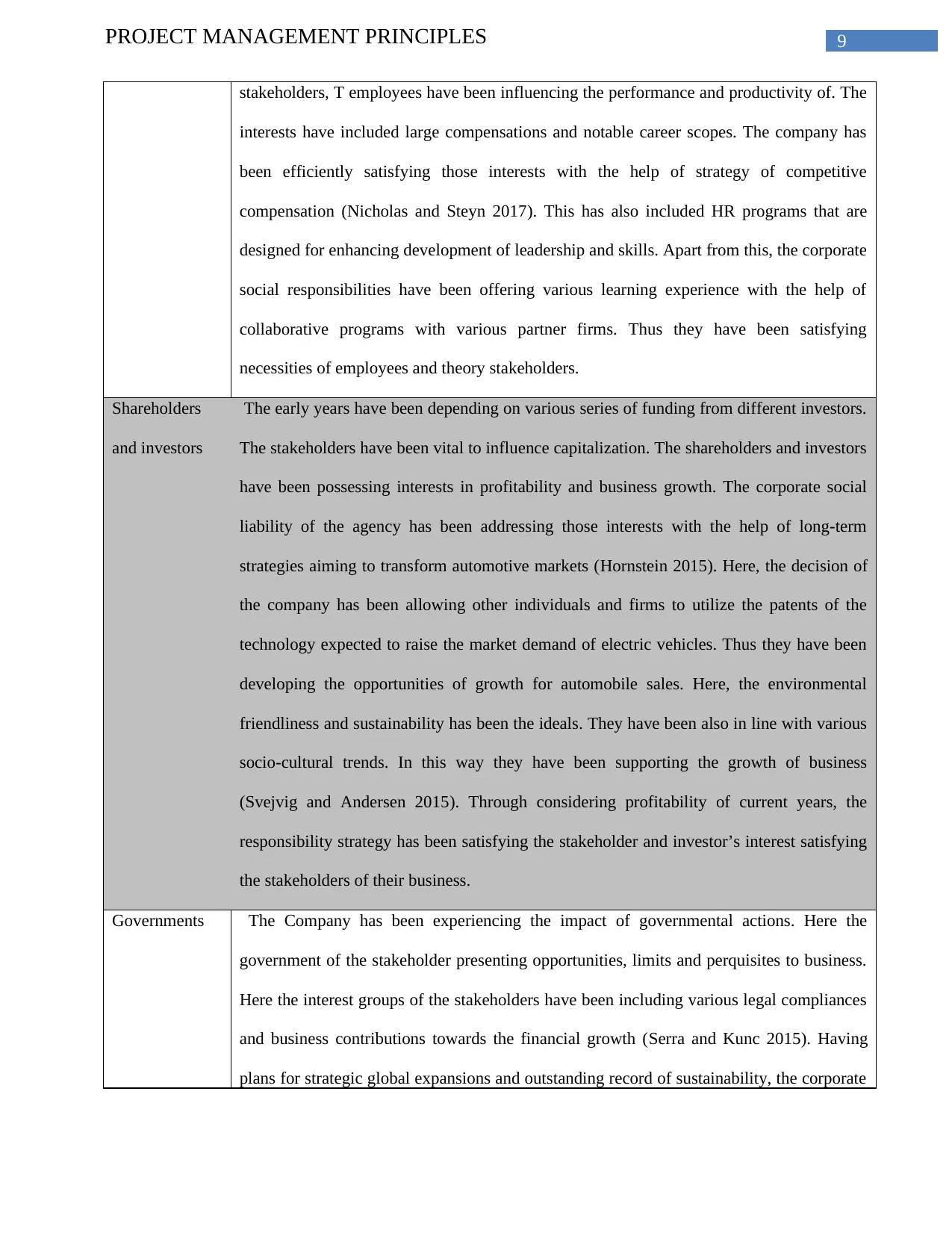
9PROJECT MANAGEMENT PRINCIPLES
stakeholders, T employees have been influencing the performance and productivity of. The
interests have included large compensations and notable career scopes. The company has
been efficiently satisfying those interests with the help of strategy of competitive
compensation (Nicholas and Steyn 2017). This has also included HR programs that are
designed for enhancing development of leadership and skills. Apart from this, the corporate
social responsibilities have been offering various learning experience with the help of
collaborative programs with various partner firms. Thus they have been satisfying
necessities of employees and theory stakeholders.
Shareholders
and investors
The early years have been depending on various series of funding from different investors.
The stakeholders have been vital to influence capitalization. The shareholders and investors
have been possessing interests in profitability and business growth. The corporate social
liability of the agency has been addressing those interests with the help of long-term
strategies aiming to transform automotive markets (Hornstein 2015). Here, the decision of
the company has been allowing other individuals and firms to utilize the patents of the
technology expected to raise the market demand of electric vehicles. Thus they have been
developing the opportunities of growth for automobile sales. Here, the environmental
friendliness and sustainability has been the ideals. They have been also in line with various
socio-cultural trends. In this way they have been supporting the growth of business
(Svejvig and Andersen 2015). Through considering profitability of current years, the
responsibility strategy has been satisfying the stakeholder and investor’s interest satisfying
the stakeholders of their business.
Governments The Company has been experiencing the impact of governmental actions. Here the
government of the stakeholder presenting opportunities, limits and perquisites to business.
Here the interest groups of the stakeholders have been including various legal compliances
and business contributions towards the financial growth (Serra and Kunc 2015). Having
plans for strategic global expansions and outstanding record of sustainability, the corporate
stakeholders, T employees have been influencing the performance and productivity of. The
interests have included large compensations and notable career scopes. The company has
been efficiently satisfying those interests with the help of strategy of competitive
compensation (Nicholas and Steyn 2017). This has also included HR programs that are
designed for enhancing development of leadership and skills. Apart from this, the corporate
social responsibilities have been offering various learning experience with the help of
collaborative programs with various partner firms. Thus they have been satisfying
necessities of employees and theory stakeholders.
Shareholders
and investors
The early years have been depending on various series of funding from different investors.
The stakeholders have been vital to influence capitalization. The shareholders and investors
have been possessing interests in profitability and business growth. The corporate social
liability of the agency has been addressing those interests with the help of long-term
strategies aiming to transform automotive markets (Hornstein 2015). Here, the decision of
the company has been allowing other individuals and firms to utilize the patents of the
technology expected to raise the market demand of electric vehicles. Thus they have been
developing the opportunities of growth for automobile sales. Here, the environmental
friendliness and sustainability has been the ideals. They have been also in line with various
socio-cultural trends. In this way they have been supporting the growth of business
(Svejvig and Andersen 2015). Through considering profitability of current years, the
responsibility strategy has been satisfying the stakeholder and investor’s interest satisfying
the stakeholders of their business.
Governments The Company has been experiencing the impact of governmental actions. Here the
government of the stakeholder presenting opportunities, limits and perquisites to business.
Here the interest groups of the stakeholders have been including various legal compliances
and business contributions towards the financial growth (Serra and Kunc 2015). Having
plans for strategic global expansions and outstanding record of sustainability, the corporate
Paraphrase This Document
Need a fresh take? Get an instant paraphrase of this document with our AI Paraphraser
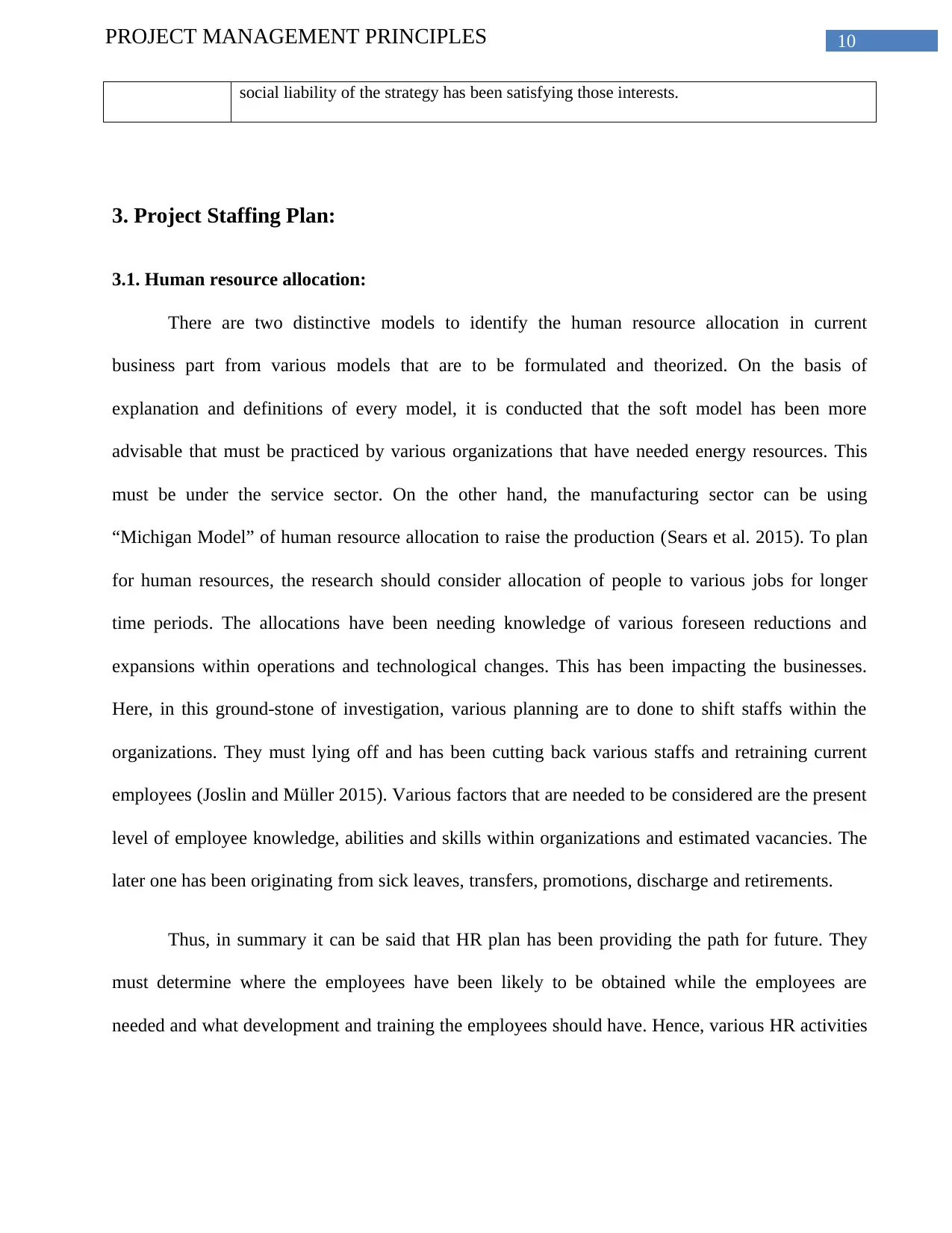
10PROJECT MANAGEMENT PRINCIPLES
social liability of the strategy has been satisfying those interests.
3. Project Staffing Plan:
3.1. Human resource allocation:
There are two distinctive models to identify the human resource allocation in current
business part from various models that are to be formulated and theorized. On the basis of
explanation and definitions of every model, it is conducted that the soft model has been more
advisable that must be practiced by various organizations that have needed energy resources. This
must be under the service sector. On the other hand, the manufacturing sector can be using
“Michigan Model” of human resource allocation to raise the production (Sears et al. 2015). To plan
for human resources, the research should consider allocation of people to various jobs for longer
time periods. The allocations have been needing knowledge of various foreseen reductions and
expansions within operations and technological changes. This has been impacting the businesses.
Here, in this ground-stone of investigation, various planning are to done to shift staffs within the
organizations. They must lying off and has been cutting back various staffs and retraining current
employees (Joslin and Müller 2015). Various factors that are needed to be considered are the present
level of employee knowledge, abilities and skills within organizations and estimated vacancies. The
later one has been originating from sick leaves, transfers, promotions, discharge and retirements.
Thus, in summary it can be said that HR plan has been providing the path for future. They
must determine where the employees have been likely to be obtained while the employees are
needed and what development and training the employees should have. Hence, various HR activities
social liability of the strategy has been satisfying those interests.
3. Project Staffing Plan:
3.1. Human resource allocation:
There are two distinctive models to identify the human resource allocation in current
business part from various models that are to be formulated and theorized. On the basis of
explanation and definitions of every model, it is conducted that the soft model has been more
advisable that must be practiced by various organizations that have needed energy resources. This
must be under the service sector. On the other hand, the manufacturing sector can be using
“Michigan Model” of human resource allocation to raise the production (Sears et al. 2015). To plan
for human resources, the research should consider allocation of people to various jobs for longer
time periods. The allocations have been needing knowledge of various foreseen reductions and
expansions within operations and technological changes. This has been impacting the businesses.
Here, in this ground-stone of investigation, various planning are to done to shift staffs within the
organizations. They must lying off and has been cutting back various staffs and retraining current
employees (Joslin and Müller 2015). Various factors that are needed to be considered are the present
level of employee knowledge, abilities and skills within organizations and estimated vacancies. The
later one has been originating from sick leaves, transfers, promotions, discharge and retirements.
Thus, in summary it can be said that HR plan has been providing the path for future. They
must determine where the employees have been likely to be obtained while the employees are
needed and what development and training the employees should have. Hence, various HR activities
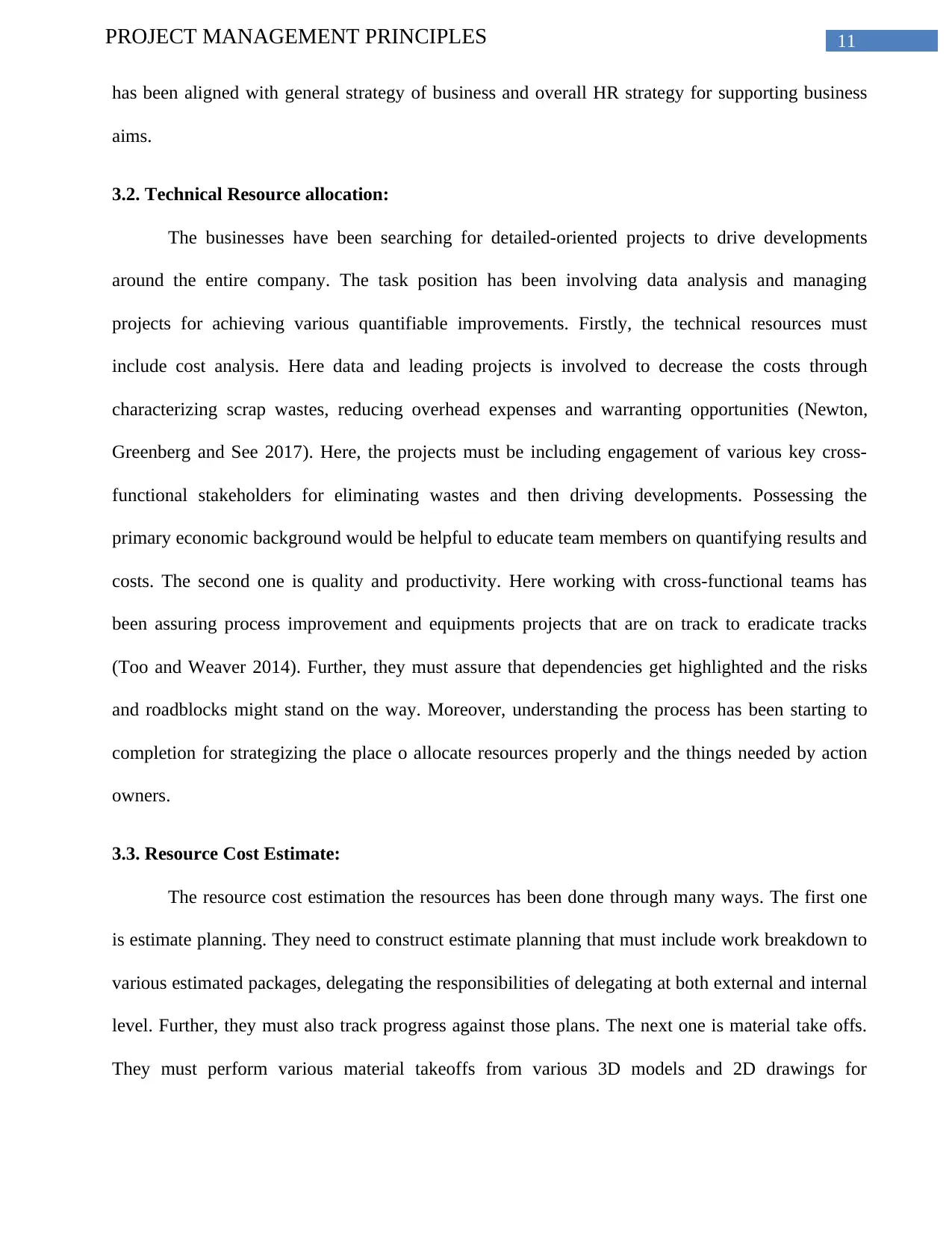
11PROJECT MANAGEMENT PRINCIPLES
has been aligned with general strategy of business and overall HR strategy for supporting business
aims.
3.2. Technical Resource allocation:
The businesses have been searching for detailed-oriented projects to drive developments
around the entire company. The task position has been involving data analysis and managing
projects for achieving various quantifiable improvements. Firstly, the technical resources must
include cost analysis. Here data and leading projects is involved to decrease the costs through
characterizing scrap wastes, reducing overhead expenses and warranting opportunities (Newton,
Greenberg and See 2017). Here, the projects must be including engagement of various key cross-
functional stakeholders for eliminating wastes and then driving developments. Possessing the
primary economic background would be helpful to educate team members on quantifying results and
costs. The second one is quality and productivity. Here working with cross-functional teams has
been assuring process improvement and equipments projects that are on track to eradicate tracks
(Too and Weaver 2014). Further, they must assure that dependencies get highlighted and the risks
and roadblocks might stand on the way. Moreover, understanding the process has been starting to
completion for strategizing the place o allocate resources properly and the things needed by action
owners.
3.3. Resource Cost Estimate:
The resource cost estimation the resources has been done through many ways. The first one
is estimate planning. They need to construct estimate planning that must include work breakdown to
various estimated packages, delegating the responsibilities of delegating at both external and internal
level. Further, they must also track progress against those plans. The next one is material take offs.
They must perform various material takeoffs from various 3D models and 2D drawings for
has been aligned with general strategy of business and overall HR strategy for supporting business
aims.
3.2. Technical Resource allocation:
The businesses have been searching for detailed-oriented projects to drive developments
around the entire company. The task position has been involving data analysis and managing
projects for achieving various quantifiable improvements. Firstly, the technical resources must
include cost analysis. Here data and leading projects is involved to decrease the costs through
characterizing scrap wastes, reducing overhead expenses and warranting opportunities (Newton,
Greenberg and See 2017). Here, the projects must be including engagement of various key cross-
functional stakeholders for eliminating wastes and then driving developments. Possessing the
primary economic background would be helpful to educate team members on quantifying results and
costs. The second one is quality and productivity. Here working with cross-functional teams has
been assuring process improvement and equipments projects that are on track to eradicate tracks
(Too and Weaver 2014). Further, they must assure that dependencies get highlighted and the risks
and roadblocks might stand on the way. Moreover, understanding the process has been starting to
completion for strategizing the place o allocate resources properly and the things needed by action
owners.
3.3. Resource Cost Estimate:
The resource cost estimation the resources has been done through many ways. The first one
is estimate planning. They need to construct estimate planning that must include work breakdown to
various estimated packages, delegating the responsibilities of delegating at both external and internal
level. Further, they must also track progress against those plans. The next one is material take offs.
They must perform various material takeoffs from various 3D models and 2D drawings for
⊘ This is a preview!⊘
Do you want full access?
Subscribe today to unlock all pages.

Trusted by 1+ million students worldwide
1 out of 25
Related Documents
Your All-in-One AI-Powered Toolkit for Academic Success.
+13062052269
info@desklib.com
Available 24*7 on WhatsApp / Email
![[object Object]](/_next/static/media/star-bottom.7253800d.svg)
Unlock your academic potential
Copyright © 2020–2025 A2Z Services. All Rights Reserved. Developed and managed by ZUCOL.




